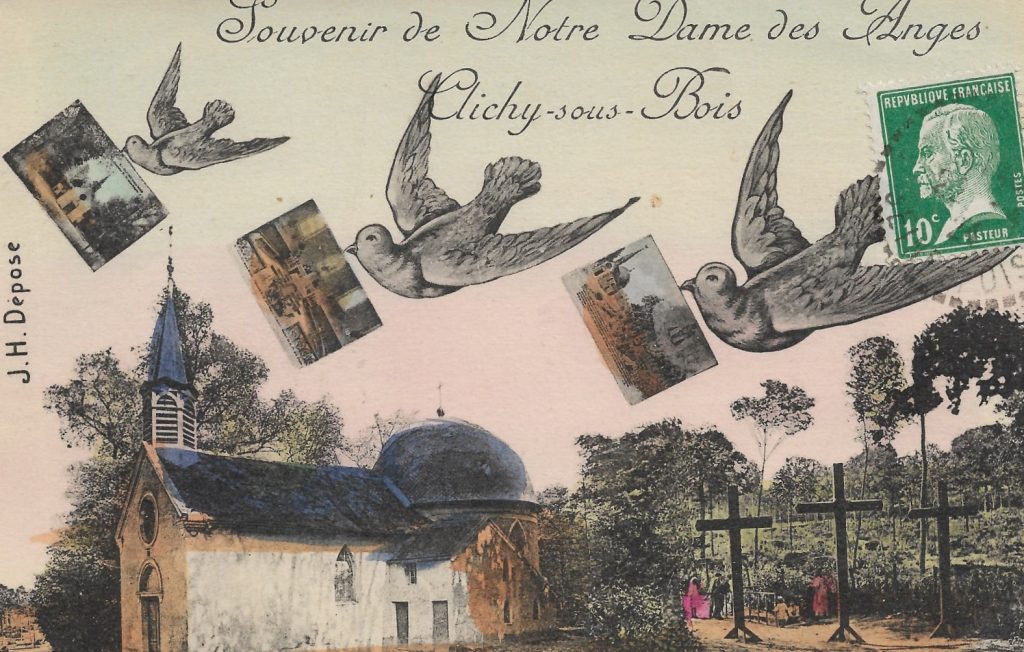Mary Irvine
Souvenir of a Different
Notre Dame

This postcard depicts a beautiful scene and three doves, each with a postcard in its beak, flying over a little French church, Notre Dame des Anges in Clichy-sous-Bois.
A small group of postcards in my collection are ones that show “postcards on a postcard.” In this case each postcard held by a bird shows exterior or interior views of the very church they are flying over.
The church website tells the story of three merchants from Anjou who, in 1212 were travelling through the forest of Bondy. Bandits robbed them and tied them to trees, then left them for dead. During this terrible ordeal the three resisted, both physically and in prayer. They prayed to the Virgin Mary who sent an angel to save them. Their bonds fell off. In honor of this miracle, the merchants built an altar.
Later a chapel called Notre-Dame-des-Angevins was built. The name was soon abbreviated to Notre-Dame-des-Anges. Three crosses were also erected to, presumably, represent the three merchants that were delivered by the angel. The crosses are visible in the postcard image.
This site is a place of pilgrimage, even today.
The card was sent by G. H. Bienzfaity (by best guess!) and was sent to Monsieur et Madame Po, 36 Rue Bolivar, Paris, 19th.
The address of Mr. and Mrs. Po is in the 19th arrondissement of Paris. [An arrondissement is an administrative district of the city. Most are unique, village like settings characterized by individual social, economic and historical circumstances.] The twenty Parisian arrondissements are arranged in the form of a clockwise spiral (often likened to a snail shell), starting from the middle of the city, with the first on the right bank (north side) of the Seine. The street is now called Rue de Simon Bolivar and Google earth shows it to a be tree-lined street, with five and seven story apartment houses. [Many Paris streets are tree-lined, so this is of little distinction, except to say it is typical with all the kinds of shops and stores that could be expected in modern Paris: a glasses emporium, an audio shop, a real estate agent, and others.]
Number 36 appears to be an elegant Parisian apartment building with wrought iron balconies. The entrance is a pair of tall wooden doors tucked between two small shops. Since the card was mailed in 1921, it may be safe to assume that Number 36 looks much like it did when the card was delivered 100 years ago.
The birds on the card that I called doves, may in fact be pigeons. Wikipedia tells me that “Pigeon Post is the use of homing pigeons to carry messages. Pigeons are effective as messengers due to their natural homing abilities. The pigeons are transported to a destination in cages, where messages are attached, then the pigeon naturally flies back to its home where the recipient could read the message. They have been used in many places around the world.”
Some may argue that a dove is a pigeon since pigeons and doves belong to the same family of birds. If the birds on this card are doves and not pigeons, then stories of doves carrying things go back a very long way since it was a dove that carried an olive leaf back to Noah in the ark.
A beautiful story to go with a beautiful card…
Interesting that the stamp is affixed to the front of the card. I wonder if such placement conveyed a secret message.
It was a standard practice in France to “stamp” the picture side of the card. See Postcard History’s article on the Universal Postal Union.
A terrific card and interesting write up. Thank you.
Thanks Bob. It’s a beautiful postcard.